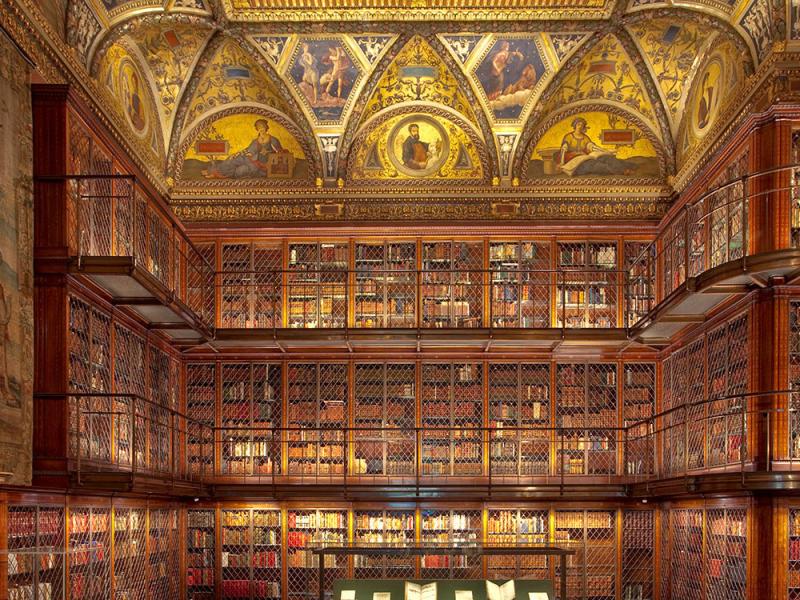The Library is by far the largest and grandest of the rooms in J. Pierpont Morgan’s Library. The walls, reaching to a height of thirty feet, are lined floor to ceiling with triple tiers of bookcases fashioned of bronze and inlaid Circassian walnut. Two staircases, concealed behind bookcases at the corners of the room, provide access to the balconies above. A pair of casement windows, incorporating fragments of stained glass, provides illumination from the north.
The mantelpiece on the east wall of the Library is carved of Istrian marble in the Renaissance style. Above is a tapestry, The Triumph of Avarice, with a moralizing Latin inscription that translates, "As Tantalus is ever thirsty in the midst of water, so is the miser always desirous of riches." The tapestry belongs to a series depicting the Seven Deadly Sins, designed by Pieter Coecke van Aelst (1502–50), the father-in-law of Pieter Bruegel the Elder. It was produced in Brussels in 1545 by the workshop of Willem de Pannemaker (active 1535–78). Four other tapestries from the series are in the Spanish royal collections, and a complete series of seven is in Vienna's Kunsthistorisches Museum.
Library Ceiling
H. Siddons Mowbray's decorative scheme for the lunettes in the Library incorporates two series of figures. Representations of "muses" and their attributes, derived from Pinturicchio's sibyls in the Church of Santa Maria del Popolo in Rome (ca. 1508–9), alternate with cultural luminaries of the past. Beginning directly above the fireplace and moving to the right, these figures are Dante Alighieri, Comedy, Sandro Botticelli, Painting, Michelangelo Buonarotti, Architecture, Antonio da Sangallo, Poetry, Socrates, History, William Caxton, Music, Herodotus, Science, Galileo Galilei, Astronomy, Christopher Columbus, and Tragedy.
In the hexagonal spandrels above the great men and their muses are the signs of the zodiac, accompanied by their ruling deities from the Roman calendar. They are modeled after Baldassare Peruzzi's paintings for the garden loggia of the Villa Farnesina in Rome (ca. 1508–11). There the pictures of the constellations relate to the horoscope of Agostino Chigi, the renowned banker for whom the villa was built. Similarly, the zodiacal signs on the Library's ceiling have been arranged in ways that were meaningful to Morgan. The two signs above the doorway, isolated from the rest, are those of Aries and Gemini. These correspond, respectively, to Morgan's birth date (April 17, 1837) and to the date of his second marriage to Frances Louisa Tracy (May 31, 1865). Thus Morgan would walk under his two "lucky stars" each time he entered the room. Opposite Aries is Libra, the sign Morgan assumed as a member of the Zodiac Club, a New York gentlemen's club; and opposite Gemini is Aquarius, the sign under which his first wife, Amelia "Memie" Sturges, died. Two themes drawn from the myth of Proserpina underscore the cyclical nature of the heavenly progression.
Beginning above and to the left of Dante's portrait and reading clockwise, the spandrels depict:
Aquarius, the water carrier; Neptune enthroned
Libra, the balance; Mars and Venus
Pisces, the fishes; Minerva, with Perseus holding the head of Medusa
Scorpio, the scorpion; Diana and Actaeon
Leo, the lion; Ceres, goddess of agriculture
Capricorn, a unicorn; Juno
Pluto abducting Proserpina from the Underworld
Aries, the ram; Venus and Cupid
Gemin, the twins; Mercury
Mercury rescuing Proserpina from the underworld
Sagittarius, the archer-centaur; Vesta with the eternal flame
Cancer, the crab; Jupiter enthroned with Juno, his wife
Virgo, the Virgin; Vulcan at his forge
Taurus, the bull; Apollo and Hercules





